Romeo v Conservation Commission: Business Law Case Study & Analysis
VerifiedAdded on 2023/06/12
|7
|2256
|108
Case Study
AI Summary
This case study provides a detailed analysis of the Romeo v Conservation Commission of the Northern Territory (1998) case, focusing on the legal issues surrounding negligence, duty of care, and the liability of public authorities. The central issue revolves around whether the Conservation Commission was liable for failing to erect a barrier or warning signs near a dangerous cliff. The analysis examines key legal principles such as the calculus of negligence, obvious risk, and the evolution of occupiers' liability, referencing relevant case law including Nagle v Rottnest Island Authority and Australian Safeway Stores v Zaluzna. The application section delves into arguments presented by both the appellant and respondent, considering factors like the low probability of accidents, the potential damage to the area's natural appeal from fencing, limited resources, high burden, and obvious risk. The conclusion supports the court's decision that while the Commission owed a duty of care, there was no breach of that duty, emphasizing that the foreseeability of risk does not automatically mandate preventative action and that individuals are expected to take reasonable care for their own safety. Desklib provides access to this and similar case studies for students.
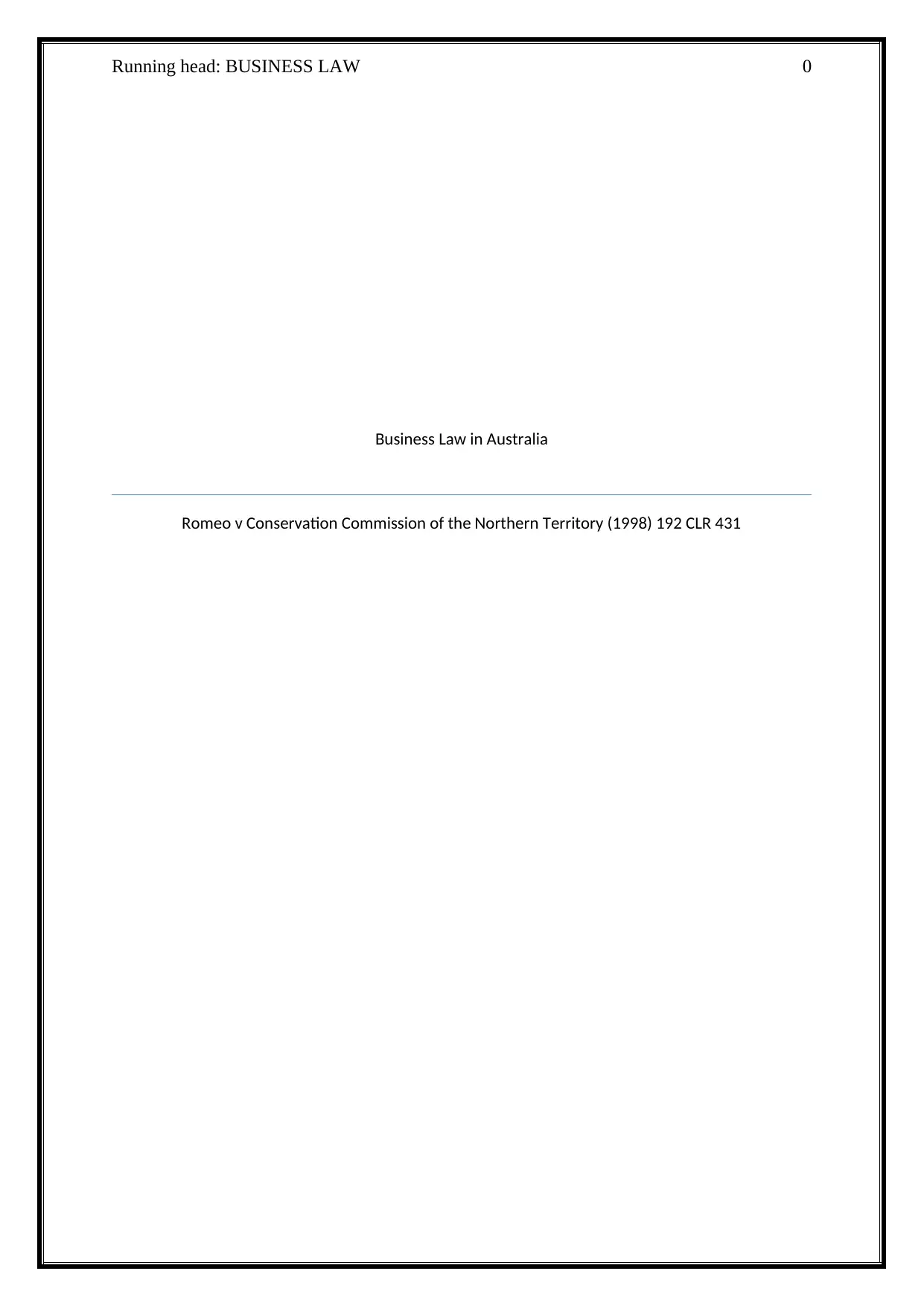
Running head: BUSINESS LAW 0
Business Law in Australia
Romeo v Conservation Commission of the Northern Territory (1998) 192 CLR 431
Business Law in Australia
Romeo v Conservation Commission of the Northern Territory (1998) 192 CLR 431
Paraphrase This Document
Need a fresh take? Get an instant paraphrase of this document with our AI Paraphraser

BUSINESS LAW 1
I: Issue
The key issue in Romeo v Conservation Commission of the Northern Territory1 case is
whether the authority is liable for not creating a barrier along the two-kilometre-long cliff.
Alternatively, it was argued that whether it is the duty of the Conservation Commission for
erecting a warning sign near the car park for warning people about the danger of the cliff. The
issues in the case are linked with breach of duty, obvious risk and calculus of negligence.
R: Rule
Negligence is referred to a breach of the duty of care which causes injury or loss to an entity
or a person to which the duty is owed. There are three essential elements of the law of
negligence which include the duty of care, breach of such duty and damages. The calculus of
negligence is defined as a process of determining whether a legal duty has been breached or
not. As per the principle of common law, a duty of care is not present in a circumstance
where a person has voluntarily assumed a risk which then materialises. An obvious risk is
referred as a risk which would have been obvious to a reasonable person2. The High Court of
Australia faces an issue of ascertaining the liability of a public authority based on the
principles of common law. The case is considered as a successor of Nagle v Rottnest Island
Authority3 case in which the judgement was given that statutory authorities have to strictly
implement policies for avoiding liability in case of negligence4. In Romeo v Conservation
Commission of the Northern Territory case, the court never disputed that the authority did not
have a duty of care, but, the judges argued that the issue is nature, content and origin of the
duty of care of the authority.
In this case, the appellant argued that the Conservation Commission of the Northern Territory
has a duty to erect fencing across the cliff in order to prevent people from falling off the cliff.
There was no adequate lighting, no warning sign regarding the danger near the cliff and n
barrier or fence to prevent people from falling off the cliff. The principle of old occupiers
liability has been changed by the doctrine of general negligence as provided in the case of
Australian Safeway Stores v Zaluzna5. The statement given by the appellant, in this case, is
1 (1998) 192 CLR 431
2 Peter Jurkovsky, "The Tort Of Negligence, Standards Of Care And Vicarious Liability" (2012) 130 Law and
Ethics: Australia and New Zealand.
3 (1993) HCA 76
4 Des Butler, Employer Liability For Workplace Trauma (Routledge, 2018).
5 (1987) HCA 7
I: Issue
The key issue in Romeo v Conservation Commission of the Northern Territory1 case is
whether the authority is liable for not creating a barrier along the two-kilometre-long cliff.
Alternatively, it was argued that whether it is the duty of the Conservation Commission for
erecting a warning sign near the car park for warning people about the danger of the cliff. The
issues in the case are linked with breach of duty, obvious risk and calculus of negligence.
R: Rule
Negligence is referred to a breach of the duty of care which causes injury or loss to an entity
or a person to which the duty is owed. There are three essential elements of the law of
negligence which include the duty of care, breach of such duty and damages. The calculus of
negligence is defined as a process of determining whether a legal duty has been breached or
not. As per the principle of common law, a duty of care is not present in a circumstance
where a person has voluntarily assumed a risk which then materialises. An obvious risk is
referred as a risk which would have been obvious to a reasonable person2. The High Court of
Australia faces an issue of ascertaining the liability of a public authority based on the
principles of common law. The case is considered as a successor of Nagle v Rottnest Island
Authority3 case in which the judgement was given that statutory authorities have to strictly
implement policies for avoiding liability in case of negligence4. In Romeo v Conservation
Commission of the Northern Territory case, the court never disputed that the authority did not
have a duty of care, but, the judges argued that the issue is nature, content and origin of the
duty of care of the authority.
In this case, the appellant argued that the Conservation Commission of the Northern Territory
has a duty to erect fencing across the cliff in order to prevent people from falling off the cliff.
There was no adequate lighting, no warning sign regarding the danger near the cliff and n
barrier or fence to prevent people from falling off the cliff. The principle of old occupiers
liability has been changed by the doctrine of general negligence as provided in the case of
Australian Safeway Stores v Zaluzna5. The statement given by the appellant, in this case, is
1 (1998) 192 CLR 431
2 Peter Jurkovsky, "The Tort Of Negligence, Standards Of Care And Vicarious Liability" (2012) 130 Law and
Ethics: Australia and New Zealand.
3 (1993) HCA 76
4 Des Butler, Employer Liability For Workplace Trauma (Routledge, 2018).
5 (1987) HCA 7
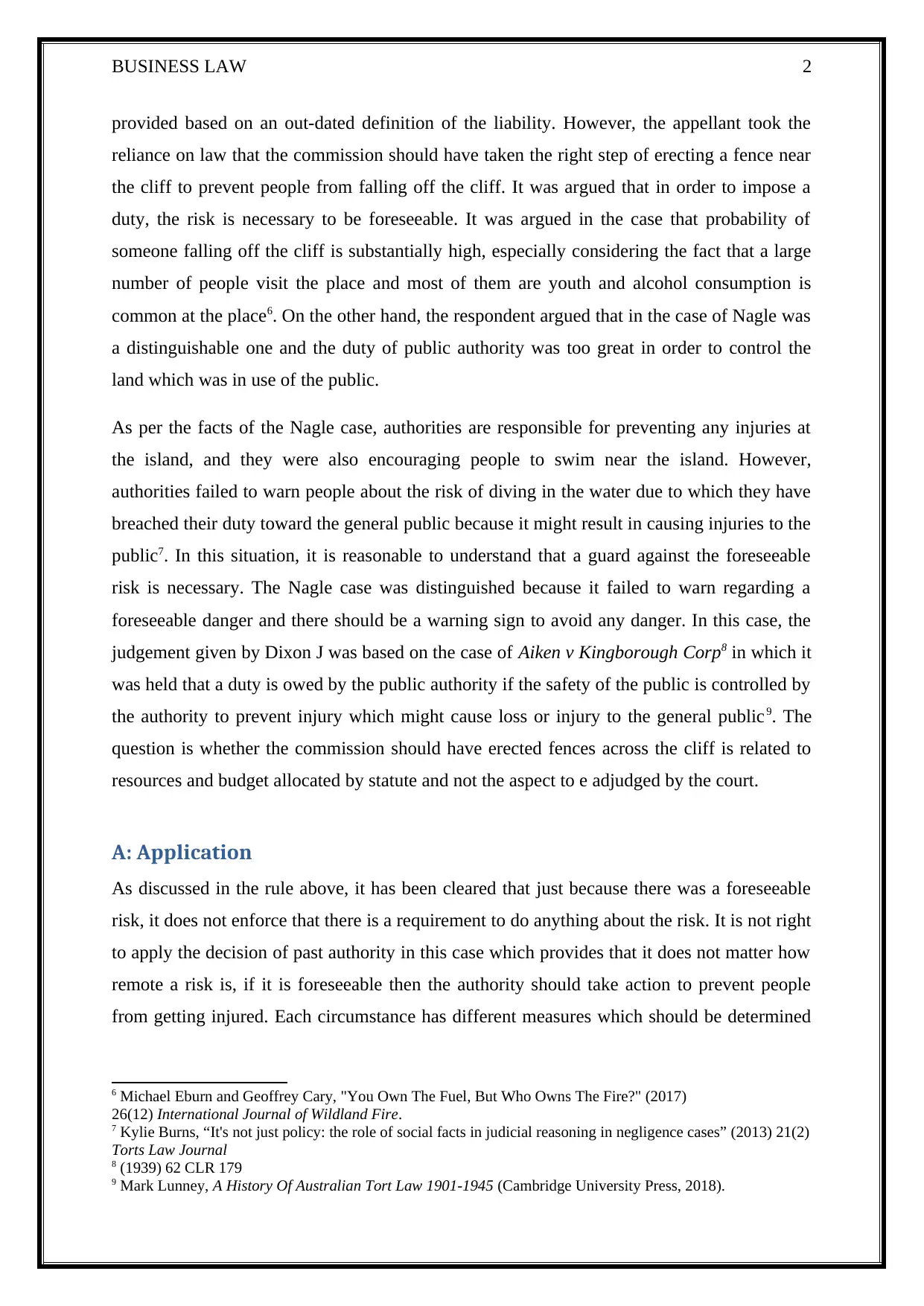
BUSINESS LAW 2
provided based on an out-dated definition of the liability. However, the appellant took the
reliance on law that the commission should have taken the right step of erecting a fence near
the cliff to prevent people from falling off the cliff. It was argued that in order to impose a
duty, the risk is necessary to be foreseeable. It was argued in the case that probability of
someone falling off the cliff is substantially high, especially considering the fact that a large
number of people visit the place and most of them are youth and alcohol consumption is
common at the place6. On the other hand, the respondent argued that in the case of Nagle was
a distinguishable one and the duty of public authority was too great in order to control the
land which was in use of the public.
As per the facts of the Nagle case, authorities are responsible for preventing any injuries at
the island, and they were also encouraging people to swim near the island. However,
authorities failed to warn people about the risk of diving in the water due to which they have
breached their duty toward the general public because it might result in causing injuries to the
public7. In this situation, it is reasonable to understand that a guard against the foreseeable
risk is necessary. The Nagle case was distinguished because it failed to warn regarding a
foreseeable danger and there should be a warning sign to avoid any danger. In this case, the
judgement given by Dixon J was based on the case of Aiken v Kingborough Corp8 in which it
was held that a duty is owed by the public authority if the safety of the public is controlled by
the authority to prevent injury which might cause loss or injury to the general public9. The
question is whether the commission should have erected fences across the cliff is related to
resources and budget allocated by statute and not the aspect to e adjudged by the court.
A: Application
As discussed in the rule above, it has been cleared that just because there was a foreseeable
risk, it does not enforce that there is a requirement to do anything about the risk. It is not right
to apply the decision of past authority in this case which provides that it does not matter how
remote a risk is, if it is foreseeable then the authority should take action to prevent people
from getting injured. Each circumstance has different measures which should be determined
6 Michael Eburn and Geoffrey Cary, "You Own The Fuel, But Who Owns The Fire?" (2017)
26(12) International Journal of Wildland Fire.
7 Kylie Burns, “It's not just policy: the role of social facts in judicial reasoning in negligence cases” (2013) 21(2)
Torts Law Journal
8 (1939) 62 CLR 179
9 Mark Lunney, A History Of Australian Tort Law 1901-1945 (Cambridge University Press, 2018).
provided based on an out-dated definition of the liability. However, the appellant took the
reliance on law that the commission should have taken the right step of erecting a fence near
the cliff to prevent people from falling off the cliff. It was argued that in order to impose a
duty, the risk is necessary to be foreseeable. It was argued in the case that probability of
someone falling off the cliff is substantially high, especially considering the fact that a large
number of people visit the place and most of them are youth and alcohol consumption is
common at the place6. On the other hand, the respondent argued that in the case of Nagle was
a distinguishable one and the duty of public authority was too great in order to control the
land which was in use of the public.
As per the facts of the Nagle case, authorities are responsible for preventing any injuries at
the island, and they were also encouraging people to swim near the island. However,
authorities failed to warn people about the risk of diving in the water due to which they have
breached their duty toward the general public because it might result in causing injuries to the
public7. In this situation, it is reasonable to understand that a guard against the foreseeable
risk is necessary. The Nagle case was distinguished because it failed to warn regarding a
foreseeable danger and there should be a warning sign to avoid any danger. In this case, the
judgement given by Dixon J was based on the case of Aiken v Kingborough Corp8 in which it
was held that a duty is owed by the public authority if the safety of the public is controlled by
the authority to prevent injury which might cause loss or injury to the general public9. The
question is whether the commission should have erected fences across the cliff is related to
resources and budget allocated by statute and not the aspect to e adjudged by the court.
A: Application
As discussed in the rule above, it has been cleared that just because there was a foreseeable
risk, it does not enforce that there is a requirement to do anything about the risk. It is not right
to apply the decision of past authority in this case which provides that it does not matter how
remote a risk is, if it is foreseeable then the authority should take action to prevent people
from getting injured. Each circumstance has different measures which should be determined
6 Michael Eburn and Geoffrey Cary, "You Own The Fuel, But Who Owns The Fire?" (2017)
26(12) International Journal of Wildland Fire.
7 Kylie Burns, “It's not just policy: the role of social facts in judicial reasoning in negligence cases” (2013) 21(2)
Torts Law Journal
8 (1939) 62 CLR 179
9 Mark Lunney, A History Of Australian Tort Law 1901-1945 (Cambridge University Press, 2018).
⊘ This is a preview!⊘
Do you want full access?
Subscribe today to unlock all pages.

Trusted by 1+ million students worldwide
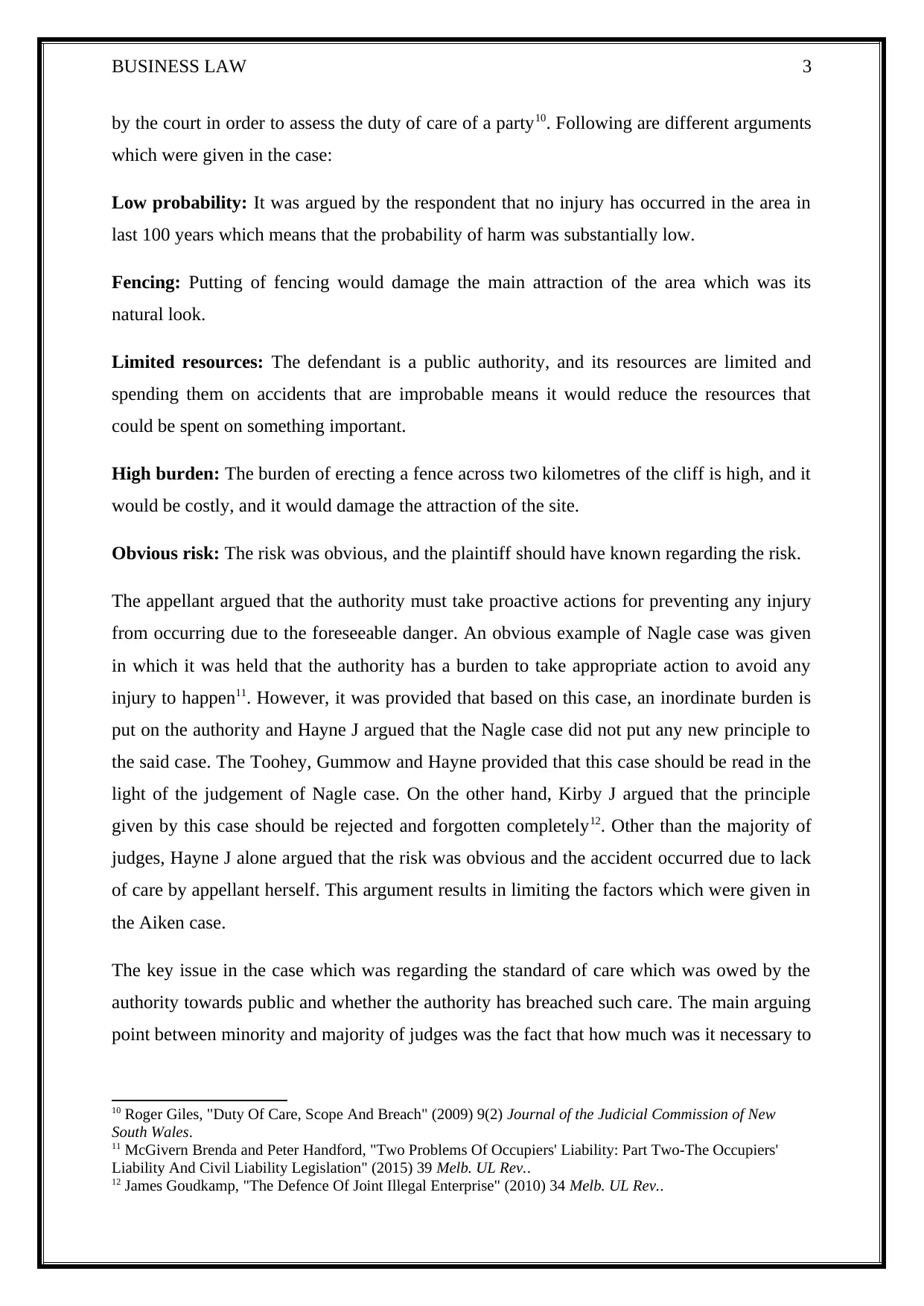
BUSINESS LAW 3
by the court in order to assess the duty of care of a party10. Following are different arguments
which were given in the case:
Low probability: It was argued by the respondent that no injury has occurred in the area in
last 100 years which means that the probability of harm was substantially low.
Fencing: Putting of fencing would damage the main attraction of the area which was its
natural look.
Limited resources: The defendant is a public authority, and its resources are limited and
spending them on accidents that are improbable means it would reduce the resources that
could be spent on something important.
High burden: The burden of erecting a fence across two kilometres of the cliff is high, and it
would be costly, and it would damage the attraction of the site.
Obvious risk: The risk was obvious, and the plaintiff should have known regarding the risk.
The appellant argued that the authority must take proactive actions for preventing any injury
from occurring due to the foreseeable danger. An obvious example of Nagle case was given
in which it was held that the authority has a burden to take appropriate action to avoid any
injury to happen11. However, it was provided that based on this case, an inordinate burden is
put on the authority and Hayne J argued that the Nagle case did not put any new principle to
the said case. The Toohey, Gummow and Hayne provided that this case should be read in the
light of the judgement of Nagle case. On the other hand, Kirby J argued that the principle
given by this case should be rejected and forgotten completely12. Other than the majority of
judges, Hayne J alone argued that the risk was obvious and the accident occurred due to lack
of care by appellant herself. This argument results in limiting the factors which were given in
the Aiken case.
The key issue in the case which was regarding the standard of care which was owed by the
authority towards public and whether the authority has breached such care. The main arguing
point between minority and majority of judges was the fact that how much was it necessary to
10 Roger Giles, "Duty Of Care, Scope And Breach" (2009) 9(2) Journal of the Judicial Commission of New
South Wales.
11 McGivern Brenda and Peter Handford, "Two Problems Of Occupiers' Liability: Part Two-The Occupiers'
Liability And Civil Liability Legislation" (2015) 39 Melb. UL Rev..
12 James Goudkamp, "The Defence Of Joint Illegal Enterprise" (2010) 34 Melb. UL Rev..
by the court in order to assess the duty of care of a party10. Following are different arguments
which were given in the case:
Low probability: It was argued by the respondent that no injury has occurred in the area in
last 100 years which means that the probability of harm was substantially low.
Fencing: Putting of fencing would damage the main attraction of the area which was its
natural look.
Limited resources: The defendant is a public authority, and its resources are limited and
spending them on accidents that are improbable means it would reduce the resources that
could be spent on something important.
High burden: The burden of erecting a fence across two kilometres of the cliff is high, and it
would be costly, and it would damage the attraction of the site.
Obvious risk: The risk was obvious, and the plaintiff should have known regarding the risk.
The appellant argued that the authority must take proactive actions for preventing any injury
from occurring due to the foreseeable danger. An obvious example of Nagle case was given
in which it was held that the authority has a burden to take appropriate action to avoid any
injury to happen11. However, it was provided that based on this case, an inordinate burden is
put on the authority and Hayne J argued that the Nagle case did not put any new principle to
the said case. The Toohey, Gummow and Hayne provided that this case should be read in the
light of the judgement of Nagle case. On the other hand, Kirby J argued that the principle
given by this case should be rejected and forgotten completely12. Other than the majority of
judges, Hayne J alone argued that the risk was obvious and the accident occurred due to lack
of care by appellant herself. This argument results in limiting the factors which were given in
the Aiken case.
The key issue in the case which was regarding the standard of care which was owed by the
authority towards public and whether the authority has breached such care. The main arguing
point between minority and majority of judges was the fact that how much was it necessary to
10 Roger Giles, "Duty Of Care, Scope And Breach" (2009) 9(2) Journal of the Judicial Commission of New
South Wales.
11 McGivern Brenda and Peter Handford, "Two Problems Of Occupiers' Liability: Part Two-The Occupiers'
Liability And Civil Liability Legislation" (2015) 39 Melb. UL Rev..
12 James Goudkamp, "The Defence Of Joint Illegal Enterprise" (2010) 34 Melb. UL Rev..
Paraphrase This Document
Need a fresh take? Get an instant paraphrase of this document with our AI Paraphraser
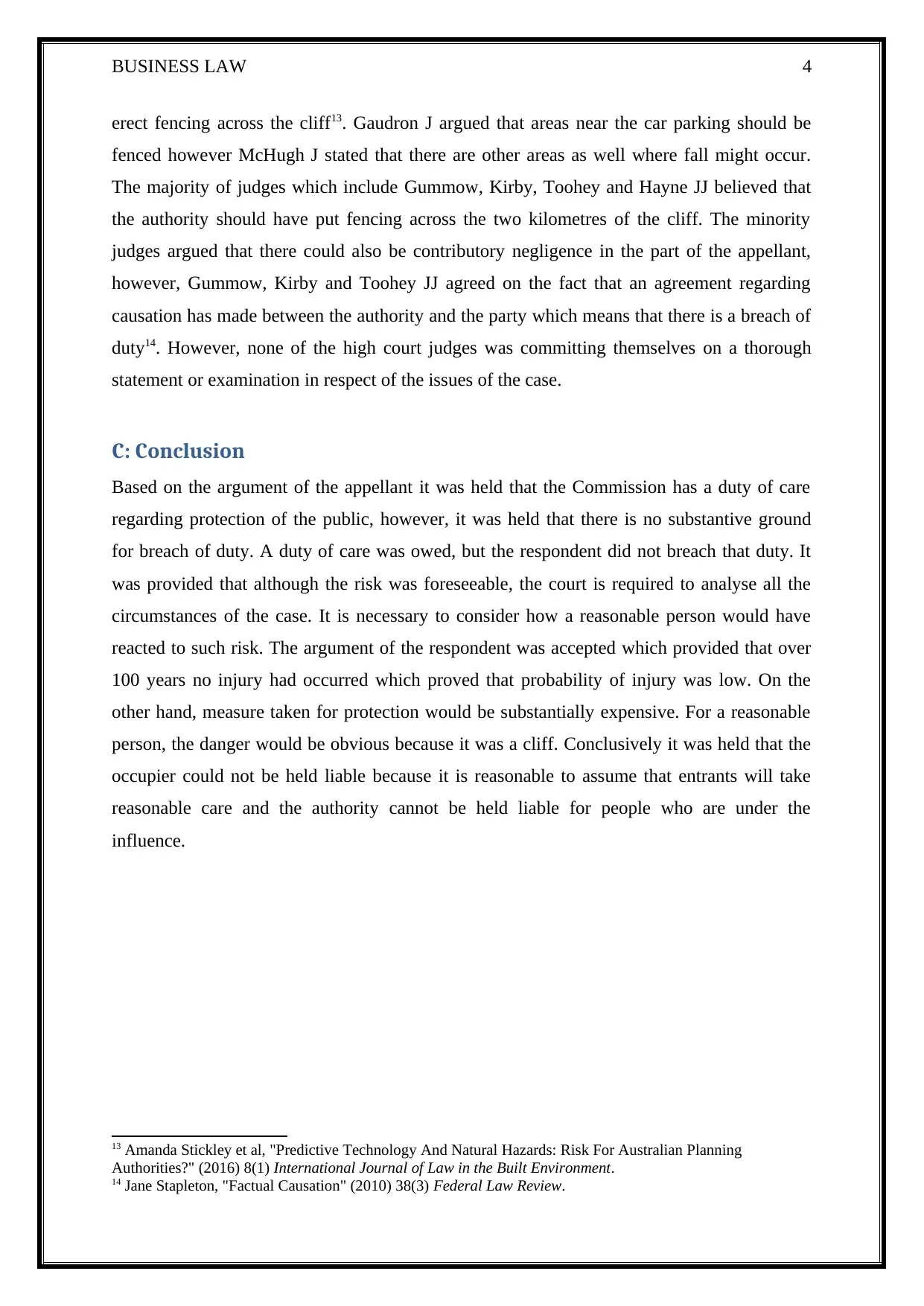
BUSINESS LAW 4
erect fencing across the cliff13. Gaudron J argued that areas near the car parking should be
fenced however McHugh J stated that there are other areas as well where fall might occur.
The majority of judges which include Gummow, Kirby, Toohey and Hayne JJ believed that
the authority should have put fencing across the two kilometres of the cliff. The minority
judges argued that there could also be contributory negligence in the part of the appellant,
however, Gummow, Kirby and Toohey JJ agreed on the fact that an agreement regarding
causation has made between the authority and the party which means that there is a breach of
duty14. However, none of the high court judges was committing themselves on a thorough
statement or examination in respect of the issues of the case.
C: Conclusion
Based on the argument of the appellant it was held that the Commission has a duty of care
regarding protection of the public, however, it was held that there is no substantive ground
for breach of duty. A duty of care was owed, but the respondent did not breach that duty. It
was provided that although the risk was foreseeable, the court is required to analyse all the
circumstances of the case. It is necessary to consider how a reasonable person would have
reacted to such risk. The argument of the respondent was accepted which provided that over
100 years no injury had occurred which proved that probability of injury was low. On the
other hand, measure taken for protection would be substantially expensive. For a reasonable
person, the danger would be obvious because it was a cliff. Conclusively it was held that the
occupier could not be held liable because it is reasonable to assume that entrants will take
reasonable care and the authority cannot be held liable for people who are under the
influence.
13 Amanda Stickley et al, "Predictive Technology And Natural Hazards: Risk For Australian Planning
Authorities?" (2016) 8(1) International Journal of Law in the Built Environment.
14 Jane Stapleton, "Factual Causation" (2010) 38(3) Federal Law Review.
erect fencing across the cliff13. Gaudron J argued that areas near the car parking should be
fenced however McHugh J stated that there are other areas as well where fall might occur.
The majority of judges which include Gummow, Kirby, Toohey and Hayne JJ believed that
the authority should have put fencing across the two kilometres of the cliff. The minority
judges argued that there could also be contributory negligence in the part of the appellant,
however, Gummow, Kirby and Toohey JJ agreed on the fact that an agreement regarding
causation has made between the authority and the party which means that there is a breach of
duty14. However, none of the high court judges was committing themselves on a thorough
statement or examination in respect of the issues of the case.
C: Conclusion
Based on the argument of the appellant it was held that the Commission has a duty of care
regarding protection of the public, however, it was held that there is no substantive ground
for breach of duty. A duty of care was owed, but the respondent did not breach that duty. It
was provided that although the risk was foreseeable, the court is required to analyse all the
circumstances of the case. It is necessary to consider how a reasonable person would have
reacted to such risk. The argument of the respondent was accepted which provided that over
100 years no injury had occurred which proved that probability of injury was low. On the
other hand, measure taken for protection would be substantially expensive. For a reasonable
person, the danger would be obvious because it was a cliff. Conclusively it was held that the
occupier could not be held liable because it is reasonable to assume that entrants will take
reasonable care and the authority cannot be held liable for people who are under the
influence.
13 Amanda Stickley et al, "Predictive Technology And Natural Hazards: Risk For Australian Planning
Authorities?" (2016) 8(1) International Journal of Law in the Built Environment.
14 Jane Stapleton, "Factual Causation" (2010) 38(3) Federal Law Review.
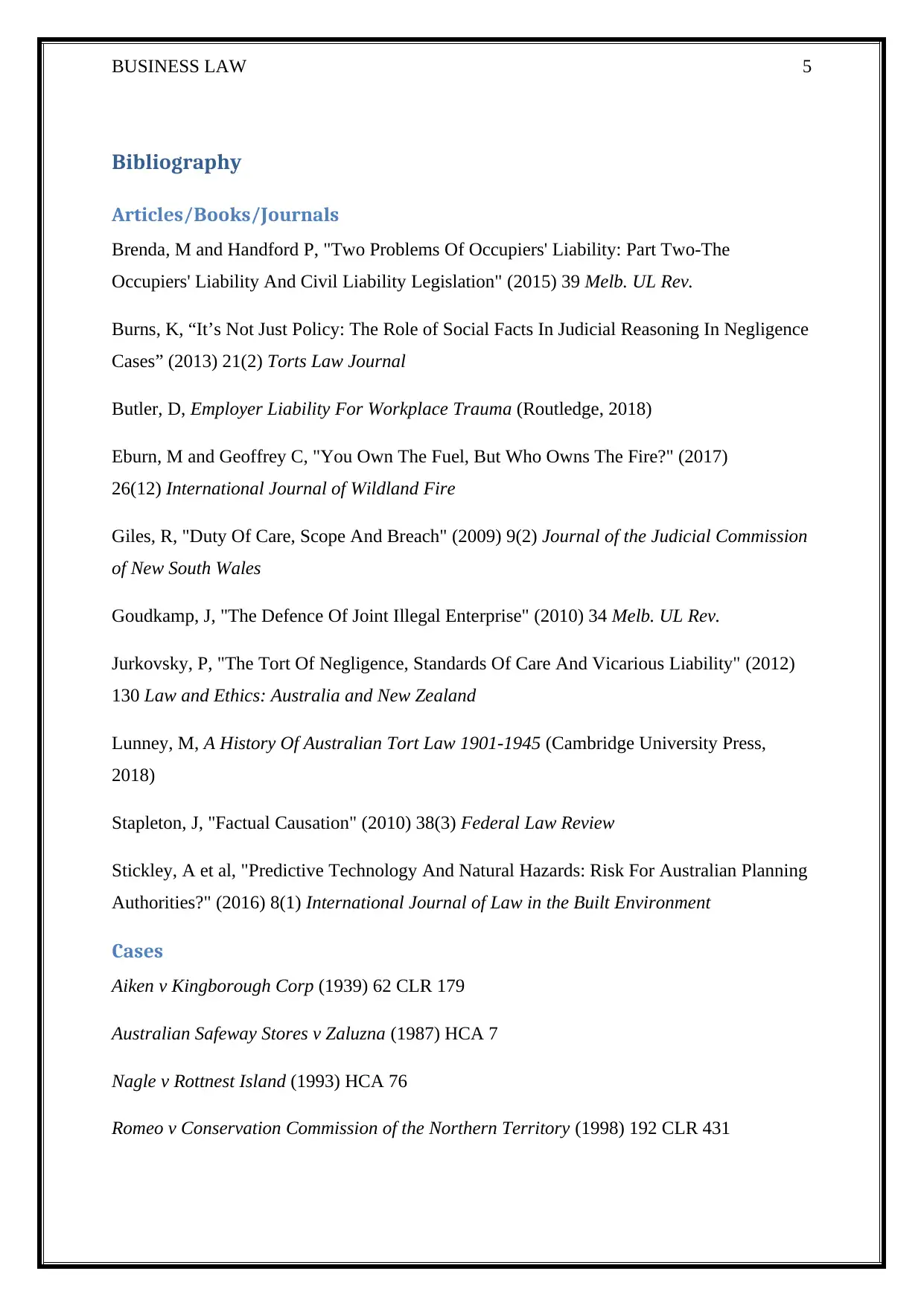
BUSINESS LAW 5
Bibliography
Articles/Books/Journals
Brenda, M and Handford P, "Two Problems Of Occupiers' Liability: Part Two-The
Occupiers' Liability And Civil Liability Legislation" (2015) 39 Melb. UL Rev.
Burns, K, “It’s Not Just Policy: The Role of Social Facts In Judicial Reasoning In Negligence
Cases” (2013) 21(2) Torts Law Journal
Butler, D, Employer Liability For Workplace Trauma (Routledge, 2018)
Eburn, M and Geoffrey C, "You Own The Fuel, But Who Owns The Fire?" (2017)
26(12) International Journal of Wildland Fire
Giles, R, "Duty Of Care, Scope And Breach" (2009) 9(2) Journal of the Judicial Commission
of New South Wales
Goudkamp, J, "The Defence Of Joint Illegal Enterprise" (2010) 34 Melb. UL Rev.
Jurkovsky, P, "The Tort Of Negligence, Standards Of Care And Vicarious Liability" (2012)
130 Law and Ethics: Australia and New Zealand
Lunney, M, A History Of Australian Tort Law 1901-1945 (Cambridge University Press,
2018)
Stapleton, J, "Factual Causation" (2010) 38(3) Federal Law Review
Stickley, A et al, "Predictive Technology And Natural Hazards: Risk For Australian Planning
Authorities?" (2016) 8(1) International Journal of Law in the Built Environment
Cases
Aiken v Kingborough Corp (1939) 62 CLR 179
Australian Safeway Stores v Zaluzna (1987) HCA 7
Nagle v Rottnest Island (1993) HCA 76
Romeo v Conservation Commission of the Northern Territory (1998) 192 CLR 431
Bibliography
Articles/Books/Journals
Brenda, M and Handford P, "Two Problems Of Occupiers' Liability: Part Two-The
Occupiers' Liability And Civil Liability Legislation" (2015) 39 Melb. UL Rev.
Burns, K, “It’s Not Just Policy: The Role of Social Facts In Judicial Reasoning In Negligence
Cases” (2013) 21(2) Torts Law Journal
Butler, D, Employer Liability For Workplace Trauma (Routledge, 2018)
Eburn, M and Geoffrey C, "You Own The Fuel, But Who Owns The Fire?" (2017)
26(12) International Journal of Wildland Fire
Giles, R, "Duty Of Care, Scope And Breach" (2009) 9(2) Journal of the Judicial Commission
of New South Wales
Goudkamp, J, "The Defence Of Joint Illegal Enterprise" (2010) 34 Melb. UL Rev.
Jurkovsky, P, "The Tort Of Negligence, Standards Of Care And Vicarious Liability" (2012)
130 Law and Ethics: Australia and New Zealand
Lunney, M, A History Of Australian Tort Law 1901-1945 (Cambridge University Press,
2018)
Stapleton, J, "Factual Causation" (2010) 38(3) Federal Law Review
Stickley, A et al, "Predictive Technology And Natural Hazards: Risk For Australian Planning
Authorities?" (2016) 8(1) International Journal of Law in the Built Environment
Cases
Aiken v Kingborough Corp (1939) 62 CLR 179
Australian Safeway Stores v Zaluzna (1987) HCA 7
Nagle v Rottnest Island (1993) HCA 76
Romeo v Conservation Commission of the Northern Territory (1998) 192 CLR 431
⊘ This is a preview!⊘
Do you want full access?
Subscribe today to unlock all pages.

Trusted by 1+ million students worldwide

BUSINESS LAW 6
1 out of 7
Your All-in-One AI-Powered Toolkit for Academic Success.
+13062052269
info@desklib.com
Available 24*7 on WhatsApp / Email
![[object Object]](/_next/static/media/star-bottom.7253800d.svg)
Unlock your academic potential
Copyright © 2020–2026 A2Z Services. All Rights Reserved. Developed and managed by ZUCOL.


